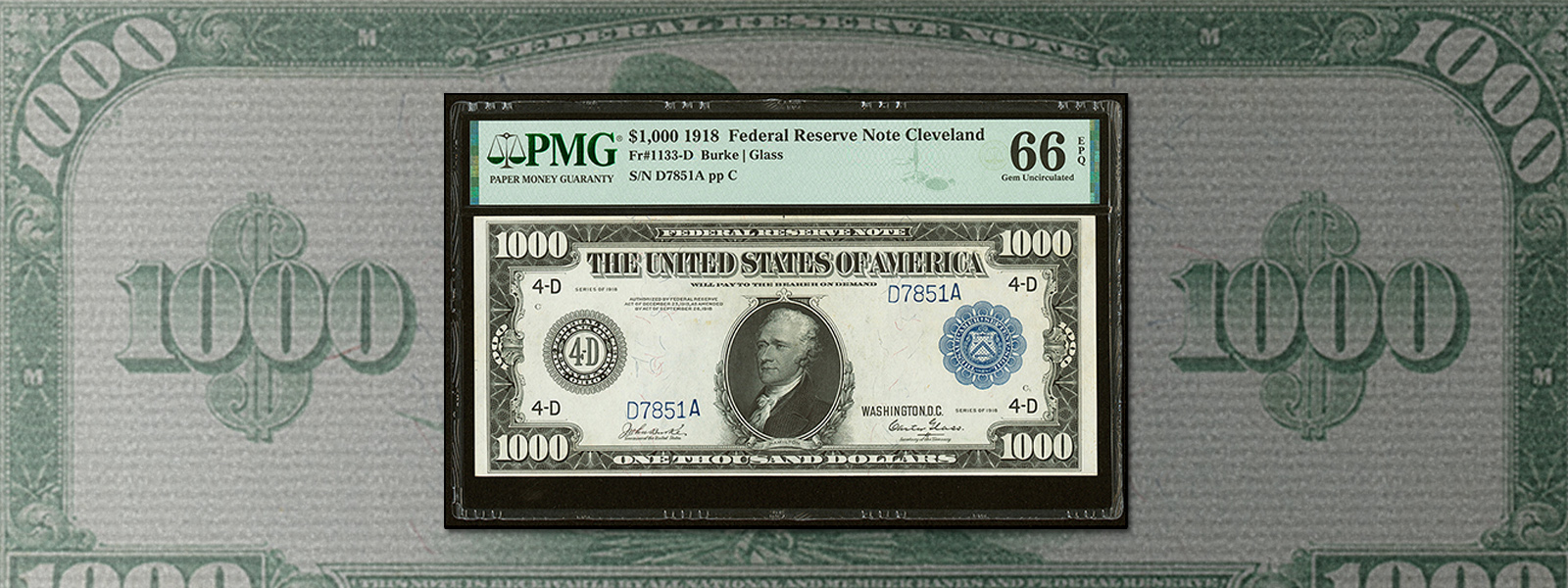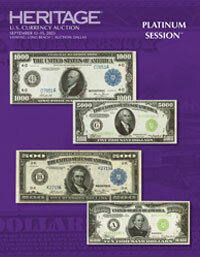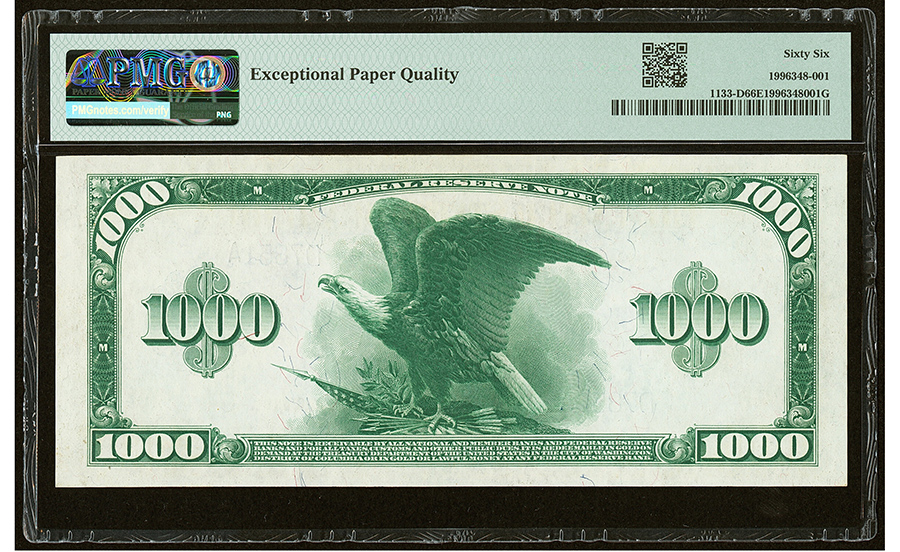TIED FOR THE FINEST GRADED, THIS 1918 FEDERAL RESERVE BANK NOTE MAKES ONLY ITS SECOND AUCTION APPEARANCE IN NEARLY 30 YEARS
Interview by Steve Lansdale
Some collectors seek out the first example of an item or the example with the largest monetary value. For others, it is the items that are exceptionally scarce or unusual that demand attention. According to Dustin Johnston, Vice President of Currency at Heritage Auctions, one of the bank notes that will cross the block in Heritage’s Long Beach Expo US Currency Signature® Auction September 13-15 is one of the rare items that meets all of those criteria.
Johnston visited with Intelligent Collector to discuss why the pre-auction interest in the Fr. 1133-D $1,000 1918 Federal Reserve Note, graded Gem Uncirculated 66 EPQ by Paper Money Guaranty (PMG), continues to climb.
Intelligent Collector: Is it the rarity of this type or the grade assigned to this example that drives the interest?
Dustin Johnston: It’s both. For pre-1928 large-size bank notes, the largest denomination available to collectors is the $1,000. The 1918 $1,000 Federal Reserve notes were remarkably scarce. In this case, added to that scarcity is the high grade, as this is tied for the finest known.
Here’s a way to look at it: The combined total of 1918 $1,000s – from all districts – was 316,400, with few survivors. To put the rarity into context, consider this: The Bureau of Engraving and Printing now prints nearly 20 million bank notes per day. So the total number of these notes that were printed over a decade of issuance for this series is less than the number printed in an hour today.
IC: Not only is this example tied for the finest known of this type, but it is also headed to auction for the first time since it was graded. Which factor is more appealing to collectors?
Johnston: The fact that it is going to auction for the first time being graded by a third party is enticing, to be sure, but being the finest known, or tied for the finest known, is more important. It declares that this is simply the finest example that can be had. This note was offered at auction in the late 1990s, and the superlatives about the condition were backed up by the grade later assigned to it by the grading service.
LONG BEACH EXPO US CURRENCY SIGNATURE® AUCTION 3593
September 13-15, 2023
Online: HA.com/3593
INQUIRIES
Dustin Johnston
214.409.1302
Dustin@HA.com
IC: Because the note is headed to auction with this assigned grade, does that add a layer of mystery or intrigue around it – for collectors and numismatists alike – because no comps can be made?
Johnston: That’s true, in part because the two other $1,000 large-size notes in this grade have not been offered at auction. Generally, we can extrapolate values based on what the next-finest notes achieved at auction and use those prices as a starting point. Then, compare the 1918 $1,000’s overall rarity to both the $5,000 and $10,000 small-size notes. It is rarer in overall number of notes known and rarer yet in high grades.
IC: How much is demand impacted by the fact that not only does this note have a high denomination, but it is also in the large-size format?
Johnston: Notes of the large-size issuing era typically have very ornate engravings and therefore are very highly regarded by collectors as works of art as much as for their currency value. Small-size notes often have a more standardized appearance, so by comparison, large, beautiful notes like this one tend to grab attention. Of note, the 1918 $1,000s are one of the very few bank notes issued to use the dollar sign, in this case flanked on either side of the rising eagle at center on back.
IC: This note comes from The Thomas Collup Collection. How does that kind of pedigree affect the way it will perform at auction?
Johnston: Thomas Collup was a very experienced collector. He was something of a quiet collector, so he was better known to dealers than to many individual collectors, but he and his collection are known and very well respected. Above all, he cherished quality as the top attribute, when it came to buying currency, but he coupled that with what was rare and scarce in high grades, so he picked the top grade of the most collected items. His experience shines through here with this note being the pinnacle of hundreds of top-grade notes in his World and U.S. Currency offerings at Heritage Auctions.
 STEVE LANSDALE is a staff writer at Intelligent Collector.
STEVE LANSDALE is a staff writer at Intelligent Collector.




